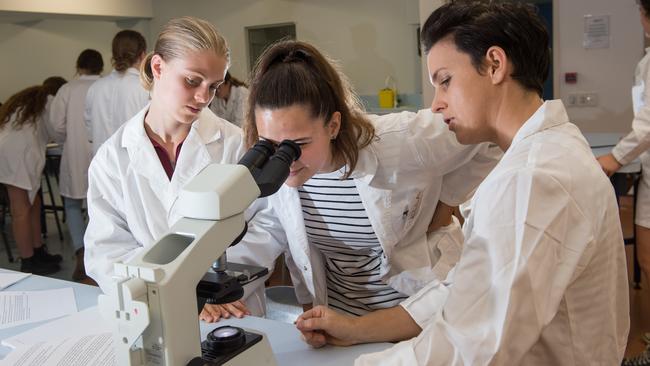Biology 2023 HSC exam guide: Selective school teacher’s tips to ace your test
Merewether High School gets more band 6 results in biology than any other school in the state. Here, teacher Ami Morrow reveals how her students do it.

Education
Don't miss out on the headlines from Education. Followed categories will be added to My News.
Tucked away in the suburbs of Newcastle, there’s a powerhouse generating the state’s highest number of top results in biology – and the subject’s head teacher is sharing their secrets to success.
At the academically selective Merewether High School, 50 biology students achieved a band six in last year’s HSC, nearly twice as many as the state’s next highest achieving school, Sydney Grammar.
Teacher Ami Morrow said the science subject is always a popular course, with the school usually accommodating 80 to 100 students, and between 40 and 50 per cent of those enrolled achieve a band six from year to year.
The secret behind the excellent results is “pretty hard to pinpoint” she said, but teachers setting questions from past papers in class is a significant factor.
“I know a lot of teachers use HSC questions for homework and that sort of thing, but we integrate past HSC questions into our teaching and learning programs so that students are coming up against questions that have been in past exams almost every lesson,” Ms Morrow said.
• WATCH: TikTok star student gives top exam hacks for HSC

It’s not just about answering the questions, however – giving and receiving feedback on those answers in the classroom is key to the school’s long track record of success in the subject, Ms Morrow explained.
“When I first started teaching, I was so focused on the content … I would set past HSC questions for homework, but then you really only get half the benefit: the real benefit comes from students marking their own responses and seeing where the gaps are.”

“I do think that the HSC focus is a big part of why our students go into the exams feeling confident, and being able to attack those questions.”
Ms Morrow said there are several pitfalls even the highest-achieving student can fall into. Here are the five biggest hurdles students need to prepare for as they head into the exam room.
FIVE TRAPS TO WATCH OUT FOR IN HSC BIOLOGY 2023
Fear of the unknown:
Ms Morrow says changes to the biology syllabus a few years ago saw a shift in testing knowledge of content, to applying that knowledge to an unfamiliar situation.

“When the 2019 HSC exam came out, and the kids came out of the exam they said, ‘There was a 20 mark question on Alzheimer’s, and you’d never taught us anything about Alzheimer’s’. I’m thinking ‘Oh my goodness, have I made a mistake here?
“But what this new HSC does is it throws really weird, unfamiliar, unseen, not-mentioned-in-the-syllabus examples and scenarios at the students and they are expected to be able to take what they’ve learned in class and apply it to something new.
“A lot of students come up against a mental block when they see questions like that. Don’t be scared off … think about how what you have learned can be applied.”
Regurgitation:
Ms Morrow says it’s a “common mistake” for students to fall back on recalling and regurgitating any information they know about a topic instead of answering the specifics of a question.

“A trap that kids tend to fall into is they tend to write what they think the question is asking – or what they want the question to be asking, because that’s something they’ve seen before – rather than answering the question that’s actually presented to them.
“They’re never going to get full marks for that question.”
Generic observations:
“Another trap students fall into if there’s a graph or a table, or some data that the students are asked to comment on, a lot of the time they’ll write a generic comment about what’s happening in the graph,” Ms Morrow says.
“For example, for a graph showing the incidence of lung cancer in smokers versus nonsmokers, they’ll make a comment that says, ‘smokers are more likely to get lung cancer’, which is true.

“But what we’d like to see them do is use the data that’s in the graph and interpret it. Say how much more likely they are, like ‘they’re ten times more likely’, or you can see that the risk for a smoker at age 50 is 10%, whereas the risk for a non-smoker is only 1%.
“Most people would know that people who smoke have a greater risk of lung cancer than people who don’t – you don’t need the graph to make that statement.”
Look out for plurals:
Ms Morrow tells her students to draw a box around plurals or limitations to avoid missing marks.
“For example, if the question says ‘support your answer with examples’ … if you only include one example, then you’re not going to get full marks in that question.
“Sometimes kids when they’re in an exam, and they’re rushing, and they’re stressed, they can miss those plurals, and it’s not because they don’t have the knowledge.”
Don’t write an essay:
Ms Morrow says it’s important to remember biology is a science subject, not English – tables, graphs and dot points are all valid ways to answer a question, and can help make the response clearer for both the student and the marker.
“I love to see students using tables, headings, subheadings, dot points, Venn diagrams, flowcharts: anything to give structure and organisation to the answer, particularly for the long responses. All of those are totally acceptable, and often quite useful tools.”




